The Human Eye and the Colourful World – Must Know!
Topic to be cover :-
1. Introduction of human eye
2. Parts of human eye and its working
3. Accommodations
4. Formation of an Image
5. Defects of vision and their correction
6. Reflection of light through a prism.
7. Dispersion of white light
8. Recombination of white light
9. The Rainbow
10. Atmospheric refraction
11. Twinkling of stars
12. Advanced sunrise and delayed sunset
13. Scattering of light
14.Tyndall effects
15. Why the sky is blue?
16. Why the sun appears red at sunrise and sunset?
The human eye:-

• The human eye is one of the valuable and sensitive sense organ in the human body.
⇒ It enables us to see the wonderful world and colours around us.
Parts of eye
I) Cornea
ii) Pupil
III) Iris
(iv) Eye Lens
(V) Retina
(vi) Optic nerves
(vii) Ciliary muscle
(viii) Sclera
(ix) Blind spot
(X) Aqueous humors
(xi) Vitreous humors
i) Cornea :-
It is the outermost parts of eye which prevent the eyeball from UV rays and maintain the shape and size of the Eyeball.
ii) Pupils :-
It is a round blackspot in front of Eye it regulates the amount of light entering the eye in case of deem light pupils expands to allow more light to enter eyes .
• In case of strong light pupil contracts allowing less light to enter.
iii) Iris
It is made up of muscles. It control the size, of pupils. Its colour depends on melanin (pigment).
iv)Eye Lens :-
Lenses lie just behind the pupils. Lenses become thin or increases the focal length this enable us to see the distant object clearly to focus of nearer object lens become thick to decrease its focal length This process is known as power of accumulation.
• The eye lens is lens made of soft and flexible proteins,
Note – The minimum distance of clear vision is 25 cm. below this distance we can’t see things clearly without stress in Eye.
⇒ far point of vision for normal eye is infinity
v) Retina :-
Retina is a bow like screen or camera film. It is full of light and colour sensitive cells . This cells upon receiving image sends electrical signal to the brain which process these information to make a mental image of what we see.
The photo receptor cells in the eye are of two types
1) Rod cells 2) Cone cells
The rod cells sensitive dim light white cone cells are sensitive to bright light and colour.
vi) Optic nerve :-
It is transmit visual information from retina to brain.
vii) Ciliary Muscle :-
The ciliary muscle is located behind the iris. it controls the movements of eye lens through suspensory ligaments.
viii) Scalera:-
It is an opaque , fibrous , protective outer layer of an eyes containing collagen and elastic fiber.
• It is also known as white part of the eye.
ix) Blind spot :-
It is a spot between retina at the intersection of optics nerves where no cones and rods are present.
• Due to which no image is formed at blind spot .
x) Aqueous Humour:-
Between the cornea and eye lens .
It has a space filled with a transparent liquid called the aqueous humor which helps the refracted light to be focus on retina.
• It also maintains intraocular pressure.
xi) Vitreous Humour
The space between the eye lens and retina is filled with another liquid called the Vitreous humor.
Power of accommodation :-
An eye can focus the image of the distance object as well as the near by objects on its retina by changing the focus length or converging power of its lens .
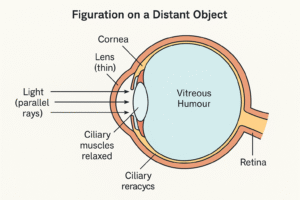
Fig :- an eye focused on distant object.
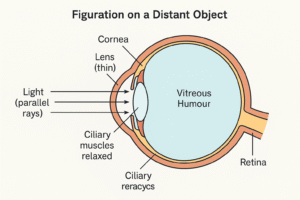
Fig :- An eye focused on near by object.
Formation of an image :-
• An image is formed on the retina by successive refraction at the cornea , the aqueous humour, lens and vitreous humour.
• It is real diminished and inverted in nature.
• The light sensitive cells of retina get activated upon illumination and generate electrical signal electrical impulses.
• These signals are then send to the brain by the optic nerves .
• The brain interpret these signals and finally process the information so that we receive objects as they are .
Defects of vision and these correction:-
I) Cataracts :-
In old age the cornea becomes cloudy this reduce the vision generally in the old age .
• It can be cured by eye surgery.
• Sometimes artificial lens is also transplant during cataract surgery this is called intraocular lens transplantation ( IOLT )
II) Myopia :-
Myopia is also known as near sightedness or short sightedness
• A person with myopia can see near by object clearly but can’t see distant object clearly.
• In myopic eye the image of distance objects form before the retina and not at the retina itself.
This effect may arise due to :-
i) Excessive curvature of the eye lens
ii) Elongation of the Eyeball.
Correction of myopic eye
III) Hypermetropia
( Long sightedness or far sightedness )
• A person with Hypermetropia can see distant objects clearly but can’t see near by objects distantly.
• The near point for the person is farther away from the normal near point 25 cm.
• The light ray from a near by objects are focused at a point behind the retina.
The defect arise either because:-
i) the focal of the eye lens is too long.
ii) the Eyeball has become too small.
IV) Presbyopia :-
• A person who can’t see farther object as well as near by objects.
• The power of accommodation of the eye usually decreases with ageing.
• For most people the near point generally reduce away.
• They find it difficult to see near by object comfortably and distinctly without corrective eyes ( glasses ) this defect is called press Byopia .
• It arises due to gradual weaking of the Calgary muscle and diminishing flexibility of the eye lens .
Correction of pres Byopia :-
I ) By focal lens – sometimes a person may suffer from both myopia and Hypermetropia such people often require by -focal lens.
– The upper portion consisting of a concave lens it fascinated distance vision
– The lower part is concave lens , it facilitates near vision
Refraction of light through a prism :-
• Prism is a transparent reflecting medium bonded by at least two triangular surfaces and it has three rectangular surfaces.
• The angle between two lateral surface is called angle of prism .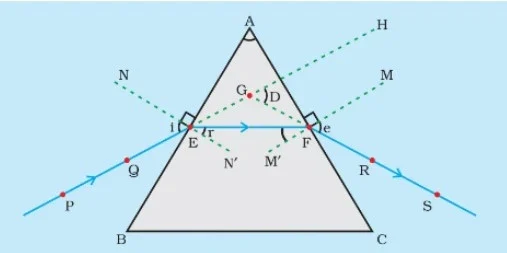
Angle of Deviation:-
It is the angle at which the emergent ray ( intended backward) make with the incident ray ( intended forward )
• It depends upon on angle of prism i.e., angle A ( < A ) , Angle of incident and angle of emergence and it is given by
S = <i + <e – <A
Where , s = Angle of Deviation
<i = Angle of Incidence
<e = Angle of emergence
<a = Angle of prism
Derivation of angle of Deviation :-
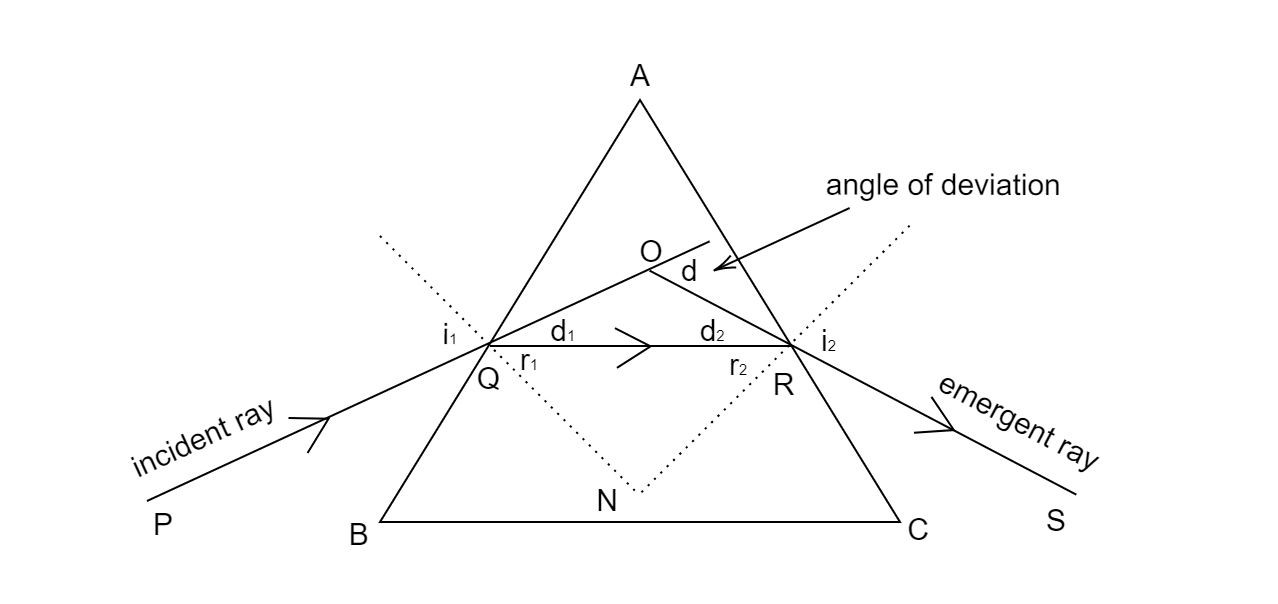
Dispersion of light :-
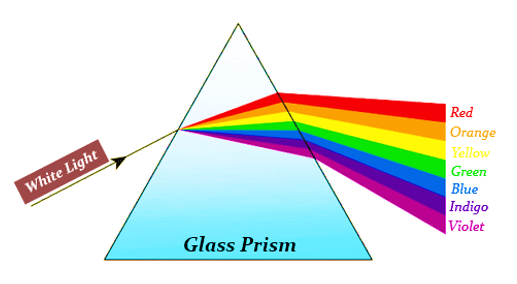
• The phenomenon of splitting of white light into its constituent colours, when it passes through a prism is called Dispersion of light.
Dispersion of white light by a glass prism :-
Cause of Dispersion:-
• Light rays of different colours travells with the same speed in vacuum and air but in any other medium they travels with different speed and bend through different angles which leads the dispersion of light.
• Red light has the maximum wave length and violet light has the minimum wave length.
• Due to the different wave length different refraction occur when white light enters in the prism.
• So , in any medium red light travels faster and deviates least white violet light travels slowest and deviates maximum.

Recombination of white light:-
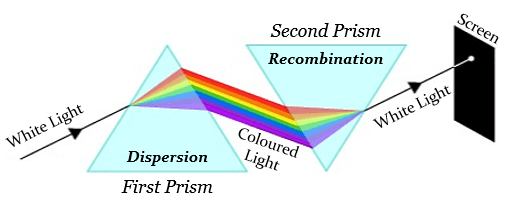
• Newton showed that the reverse of desperation of light is also possible.
• He kept two prism close to each other one is erect position and other in inverted position.
• The light gets dispersed when passes through the first prism .
• The second prism receives all the seven colour rays from first prism and combines then into original white light.
• This observation shows that sunlight is made – up of different colours.
The Rainbow :-
• A rainbow is a natural spectrum appearing in the sky after rains shower. It is because of Dispersion of sun light by tiny water droplets present in the atmosphere.
• A rainbow is always formed in the direction opposite to that of the sun light.
• The water droplet act like a small prism, they reflect and disperse the incident sunlight then reflect it internally and finally refracts .when it comes out of the raindrops.

Atmospheric refraction :-
• The earth atmosphere is not unform through out it’s density goes on changing as we move up or down .
• It can be considered to be consisting of layers of different densities , which act as rare or denser which respect to each other.
• This refraction of light caused by these layers is call atmospheric refraction.
Why do Star Twinkle:-
• Star Twinkle due to atmospheric refraction as star appears as point source , light rays coming from Star faces refraction at various layers of atmosphere.
• As density of atmosphere change continuously therefore , apparent position of star also change continuously.
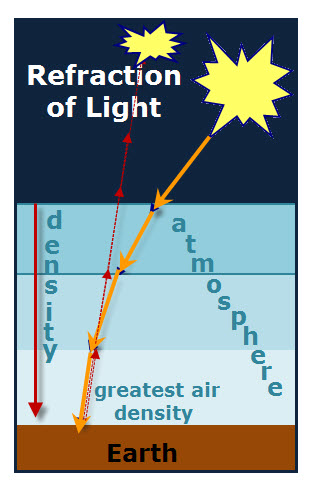
The stars seem higher than they actually are :-
v As the light from Star enters the earth atmosphere , It undergoes refraction and bends the normal each time due to the atmospheric refraction therefore the apparent position of the star is Slightly different from each actual position.
• The stars apparent to be slightly higher than the apparent position when viewed near horizon.
Advance sunrise and delayed sunset :-
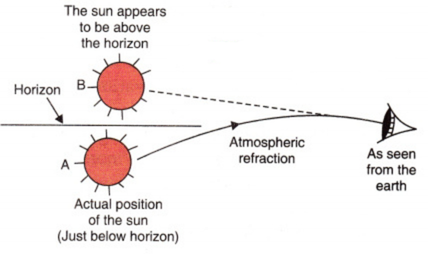
• The sun is visible to us about 2 mins before the actual Sunrise and about 2 min after the actual Sunset.
• This is because of Atmospheric refraction.
• When sun is slightly below the Horizon, the sunlight comes from the less dense to more dense air is refracted down wards because of this sun appears to be raised about the horizon and so, the sun can be seen about 2 mins before actual .
• Similarly, due to atmospheric refraction the sun can be seen for about 2 mins Even after the sun even set below horizon.
Scattering of light :-
Scattering of light is the phenomenon of change in the direction of light on scattering a particular type of particles. ( Colloidal particles) and the size of the particles will be 1nm to 1000 nm. Making the path of light visible and it was discovered the scientist John Tyndall .
Tyndall effects :-
• The scattering of light when it passes through a colloid solution is called Tyndall Effect .
• The Earth atmosphere is a heterogeneous mixture of minute particles of smoke tiny water droplets, suspended particles of dust and molecules of air which become visible due to scattering of light.

Why the sky is blue
• As white light passes through the atmosphere, tiny air molecules Cause it to scatter.
• The scattering caused by these tiny air molecules increases speed of Light decreases and the wavelength of light decreases.
• Violet and blue light have the shortest wavelength and red light has the longest .
Therefore, blue light is scatter more than red light and the sky appears blue during the day.
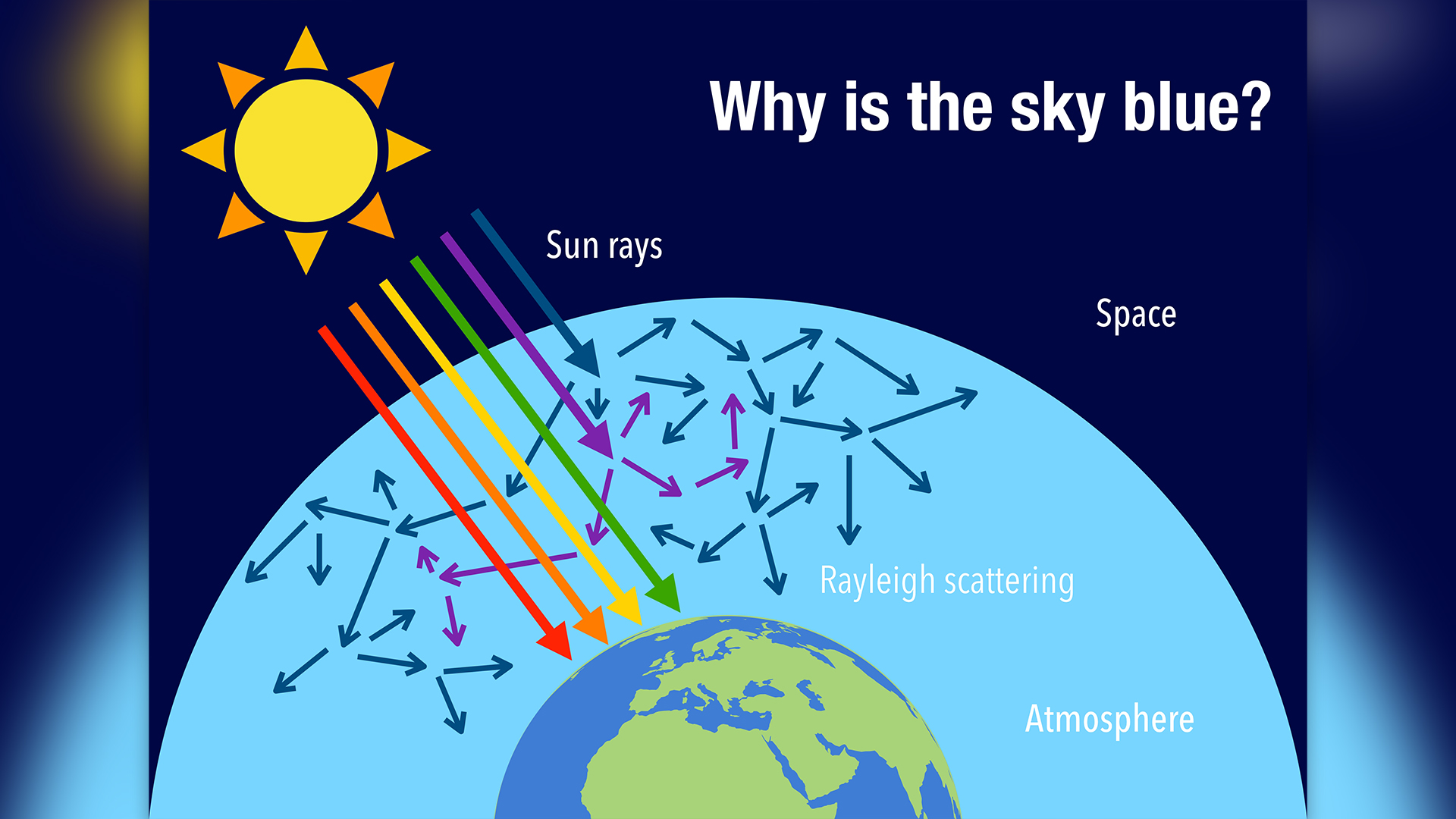
Why the sun appears red at sunrise and sunset :-
• During Sun- light and Sunset light has to travel longer distance to reach observer.
• Lose of Energy due to scattering is more for high frequency wave.
• Longest wave length wave has minimum lose due to least scattering and can travel long distances.
• Red colour has longer wave length its intensity reached to the observer is more compare to the other colours.
• Hence, the sun appears red during the sunrise or sun set
• White light is a combination of all lights. during Sunrise and Sunset rays have to travels Longer distance and as red light scatter least, it is capable to reach our eye while best of components (Colour) are scattered away Hence, sun appears reddish Orange During sunrise and Sunset.

Reflection of Light
Official Website- Physics Wallah
iOTA CLASSES has been working for the last 6 years at youtube ( online mode) but from last year ( 2024) we are running both online and offline,
With the cooperation of students , parents , our colleagues and team, we have gained satisfactory results,
And working more enthusiastically for the better aspirations. image of 2024 class 10th result [CBSE and BSEB( ENG. Med)]



Хотел сэкономить при отделке — везде то “берите только дорогое”, либо рекомендации вроде “используйте подручные материалы”. Нашел нормальные сайты, где подробно расписано, как реально можно сэкономить и получить хороший итог
Каталог